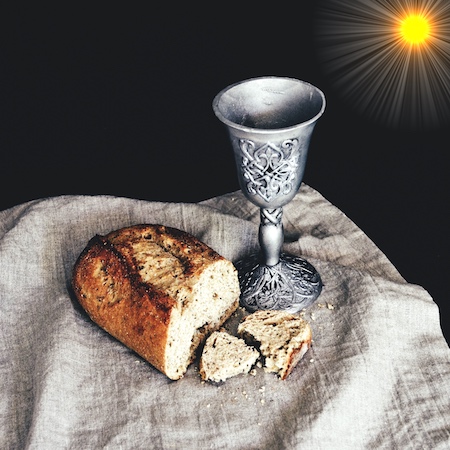Our existing arrangements for communion were:
– Communion can be bread alone or wine shared or dipped.
– If dipping bread keep fingers out of wine.
At Monday’s Council Meeting we considered how we felt about Communion in present circumstances. This led to the following provisions for Holy Communion.
- The bread will be offered by a priest with sanitised hands. S/He will avoid skin contact with people and offer a rectangularly shaped bread.
- A single chalice of wine will follow and be presented with the words: “The blood of the Lord poured out for you.” There are two ways to respond to this:
Response A) After eating your bread, cross your arms to say: “Amen.” This acknowledges the gospel of the blood without touching the cup.
Response B) Saying “Amen” and dipping your bread in the wine (without dipping fingers too!)
Some Notes:
Jesus told us to “do this in memory” of him. Communion is inherently about actions that speak to the point of invoking Jesus with reference to this saving death for us. He did not say how frequently or infrequently we should ‘do this’. Consequently churches and Christians may vary in this.
The risk assessment for viral infection at communion is not standard or obvious. It has been investigated in relation to AIDS, SARS, ‘Bird Flu’ etc. Sharing food and utensils in close proximity would seem to be high-risk enabling saliva or droplet transfer between people. However, the clinical advice is that greater risk comes through being in a group of people with unguarded coughing, hand contact along with joint touching of public surfaces such as door handles and furniture. This is especially so with Covid-19 which is several times more infectious than regular colds or flus. The risk actually begins at the church door and not at the communion table or ‘shared cup’.
Some long standing clinical assessments of shared wine at communion are:
A) Silverware which is cleaned with boiling water, as ours always is, does not retain bacteria or viral material as wood or ceramic might.
B) A high level of alcohol in the wine is hostile to bacteria and virus, but is not a complete protection.
C) While Protestant priests routinely finish the cup afterwards, no one has been known to be infected with contagions through this practice.
D) Wiping between usage reduces saliva transfer but must be done well.
E) Dipping fingers in the wine with the bread raises the risk of passing on infection. This is both via the bread in one’s fingers and directly from the fingers.
The Conclusions Are:
As the (Anglican) Church of Canada advises: ‘Communion in only one kind (the bread) is the best option for those fearful of the cup.’ Being ‘fearful’ may be totally justified by known vulnerabilities and is not to be disregarded. Communion in only one kind (the bread) is still considered as full communion by the Church of England. You are not required to take the cup in any form.
